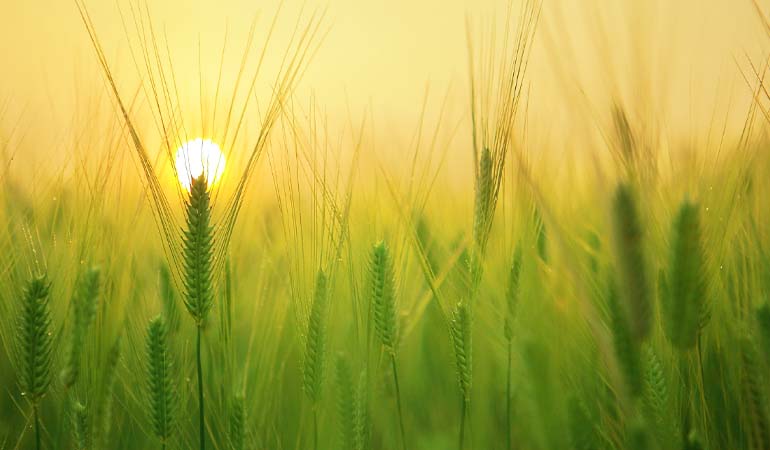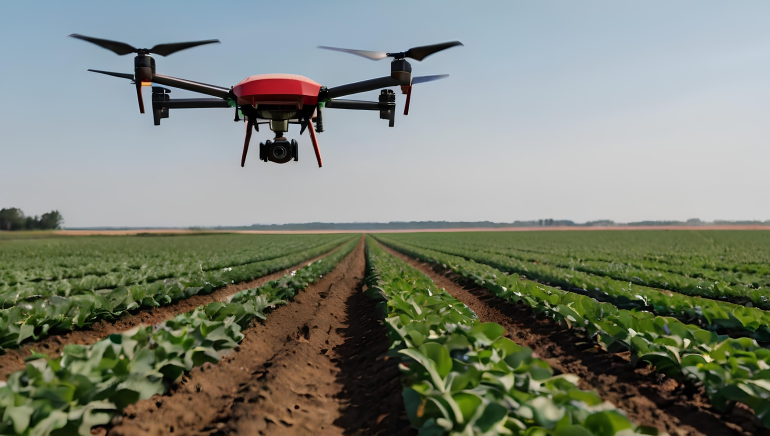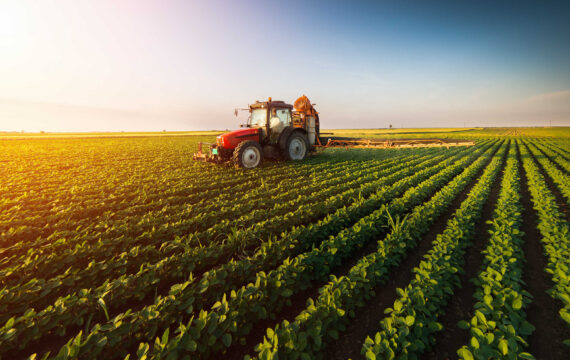Since our hunter-gatherer ancestors cultivated the first crops 12,000 years ago, agriculture has remained arguably the most important industry. But today, farmers are under increased pressure. Costs are soaring, labor shortages are increasing, and the climate is changing, with extreme weather conditions becoming more common.
One thing is clear: to navigate this stormy climate, farmers need modern solutions — like automated farming.
Read on to explore how automated farming systems are changing the game for this most essential of industries. We’ll cover the trends driving farm automation, key benefits and how Intellias can help you maximize the opportunity.
What is automated farming?
Farm automation is an emerging trend that has the potential to reshape agriculture completely. Sometimes called smart farming or precision agriculture, automated farming uses advanced technology to minimize human labor, increase process efficiency and improve profitability.
Farm automation technologies combine both digital and physical tools, powered by some of the most disruptive tech trends in the world, such as:
- Artificial intelligence (AI)
- Machine learning (ML)
- Advanced robotics
- Internet of Things (IoT)
- Data analytics
The result is a powerful network of automated farming solutions that can perform agricultural processes faster, smarter and more cost-effectively than ever before.
Trends driving automation in agriculture
Several factors are combining to drive the shift towards automated agriculture. We’ll look at some of the most important trends below.
Technological innovation
Recent years have seen rapid advancements in areas such as AI, ML and robotics. Processes that were once only possible with human effort can now be automated and enhanced. This trend isn’t specific to agriculture — it’s impacting virtually every sector. While other industries have been impacted faster, farming is starting to catch up.
Rising costs
In addition to broader technology trends, there are several key factors forcing agriculture companies to adopt new ways of working. First of all, the costs associated with farm operations have increased dramatically. For example, fertilizer and crop-protection chemicals now cost up to 250% more than they did a few years ago. These crippling overheads are forcing farmers to adopt advanced technologies with greater urgency.

Source: McKinsey
Labor challenges
Farm work is tough. Long hours, intense physical demands and exposure to the elements make it less appealing for younger generations. As a result, the average age of a farmer in the US in 2022 was 58. With more farmers reaching retirement age and not enough young workers to replace them, the agriculture industry is facing a major labor shortage. In the UK, a shortage of workers led to £60 million worth of produce rotting in the fields. Automating agriculture solves this problem altogether.
Climate change
Climate change is impacting farmers’ ability to drive a profit. Extreme weather conditions are becoming increasingly normal. Hotter, dryer conditions are impacting crop yields. This has hit US farmers particularly hard, with some regions in the American Southwest experiencing the worst drought in over a millennium. Advanced technologies and automation in agriculture can help farmers adapt to changing weather conditions faster.
Sustainability requirements
With environmental concerns growing, regulators are pushing for more sustainable farming practices. Governments are implementing stricter policies on carbon emissions, water usage and the use of pesticides. Meanwhile, consumers are demanding greater transparency in food production, favoring farms that adopt eco-friendly practices like smart irrigation systems and regenerative agriculture. Together, these changing attitudes to farming and food production are encouraging the use of precision farming technologies.
Advantages of automated farming solutions
Automated farming isn’t just about updating farm machinery. It’s about completely rethinking agricultural processes to make them more efficient, scalable and cost-effective. Here are five reasons to implement it:
1. Increased efficiency and productivity
Automation transforms farm operations by handling repetitive tasks with speed and precision. Automated harvesters can plow fields around the clock or pick crops at peak ripeness, without needing a break. Less time, less effort, more output.
This is particularly important given the world’s growing population. By 2050, it’s estimated that global agriculture production must scale by at least 70% to meet future demand. Automated farms will provide the productivity boost needed to meet that target.
2. More profitable farms
AI-powered systems can track soil health or crop management in real time, enabling farmers to optimize every acre of land. This can boost yields while saving on labor costs, resulting in greater profitability. For example, vineyards in California have enjoyed an increase in EBITDA of up to 15% by using farm automation technology.
Farm automation technologies can deliver $200 to $800 per acre in vineyards

Source: McKinsey
3. Reduced labor costs and dependency
Labor represents more than half the overall cost of running a farm. At the same time, labor shortages are making it increasingly difficult for modern farms to meet consumer demand with agricultural supply. With harvest automation and robotic farm equipment, farms can automate processes almost entirely — robots weed fields, drones monitor crops and smart irrigation systems run themselves,
This helps reduce the overall cost of labor. At the same time, farms become less reliant on manual work, resulting in more reliable and consistent outputs. It’s worth noting here that automation doesn’t eliminate all agricultural jobs. In many cases, it shifts people toward higher-skilled roles, like managing systems or reviewing data.
4. Improved crop quality and consistency
Automation takes the guesswork out of farming, ensuring that crops get exactly what they need to thrive. This is achieved through smart sensors that monitor soil health, predictive analytics that forecast changing conditions, and AI-powered models that make smart suggestions.
Automation also improves the harvest process. Robotic systems can harvest with a level of care that traditional farming equipment cannot achieve. This reduces damage and delivers consistent quality. This means better products, happier customers and stronger profits.

5. Data-driven decision-making
Data-driven companies are 19 times more likely to remain profitable — and farms are no different. Without data-driven insights, farmers are essentially relying on guesswork for major decisions. But with AI platforms that can analyze everything from weather forecasts to market trends, farmers can decide when to plant, irrigate or sell. Real-time insights from drones or IoT devices can spot issues like pests or extreme conditions early, enabling farmers to act fast.
Examples of farm automation technology
So how exactly does farm automation work in practice? We’re not talking about a single technology here, but rather a combination of technologies and tools, all connected and sharing real-time data. Let’s look at some key examples.
Sensors and IoT devices
At the heart of this network of tools are sensors and IoT devices. Think of these as the technological eyes and ears of an automated farm, able to measure things like soil moisture, temperature and nutrient levels in real time.
A farmer in California, for example, might use soil sensors to measure moisture levels. When a certain level of dryness is detected, it triggers an automated irrigation system that waters only the spots that need it.

Source: Number of active IoT connections in agriculture in millions in the European Union
Automated machines
Traditionally, farm work relied on a combination of hard physical labor and manually operated machinery. Think farmers driving tractors and harvesters, or laborers picking fruit by hand. Today, tech-savvy farms are handing these jobs over to automated machines that can perform these tasks with new levels of efficiency. Here are some examples:
- Harvest automation tools combine advanced robots, sensors and machine learning to pick crops with unbeatable precision and consistency.
- Autonomous tractors use GPS, LiDAR and AI to plow agricultural fields, plant crops and spray pesticides with unmatched accuracy.
- Automated seeding systems ensure that seeds are sown when soil conditions are just right, at optimal depths and spacing, to maximize germination and increase yields.
- Robotic weeders identify and eliminate troublesome plants with surgical precision, reducing herbicide use by up to 90%.
Drones and satellites
Modern farm equipment isn’t limited to the ground. With drones, farmers now have eyes in the sky, providing a new dimension of data insights. Combining multispectral cameras and AI-powered analytics, agriculture drones can capture data on crop health, soil moisture or pest threats on a large scale. Information that would have taken hours for a farmer to gather manually can now be accessed in minutes.

Farm management software
While robots and autonomous machines do all the heavy lifting, farm management software ties everything together in one centralized hub. Think of it like an automation control system for precision agriculture and indoor vertical farming, bringing together processes, insights and data. These platforms enable farmers to get a clear overview of farm performance. They also provide insights into finances, staffing, inventory and more. Here are some popular examples:
- Granular
- FarmLogs
- AgriWebb
- Cropwise
- Climate FieldView
Challenges of automated farming
Automated farming is the future of agriculture, but the path to adoption isn’t always smooth. Below, we’ll look at some of the major challenges farmers face when implementing autonomous farming solutions.
High upfront costs
Autonomous farming equipment doesn’t come cheap. Replacing legacy machinery with robotic harvesters, autonomous tractors and a fleet of AI-powered drones represents a huge investment in an industry that’s already stretched thin. For farms that can handle the initial outlay, these tools all provide tangible ROI going forward.
Technical complexity
Farming is a relatively traditional industry with an aging workforce that may be reluctant to adapt. Operating IoT sensors, AI software and robotic weeders may be way beyond the average farmers’ skillset. This complexity, coupled with a steep learning curve, is a major barrier to the adoption of farm automation technologies.
Reliability in extreme conditions
Farms aren’t like your average workplace. They’re muddy, dusty and unpredictable. Automation tech may work fine when conditions are normal, but when extreme weather hits — like major storms, heatwaves or arctic conditions — disruptions and damage may occur. Relying on potentially breakable tech can leave farmers in a tricky position.
Connectivity gaps
Farm automation relies heavily on connectivity. Automated farm devices need to be able to communicate and share information, forming a network of interconnected systems rather than working in isolation. When connectivity issues arise — either as a result of technical issues or slow broadband speeds — farm automation can fail.
Ethical considerations
Saving on labor costs while increasing productivity and quality is great, but there’s also a flipside to farm automation. Farm workers may fear losing their jobs, especially those involved in repetitive manual labor such as fruit picking. In most cases, however, automation will augment human farm workers rather than replace them altogether.
Intellias — your technology partner for farm automation
So how can you overcome the challenges we outlined above? Many traditional agribusinesses don’t have the experience or expertise to switch from legacy processes to precision agriculture. But by working with an expert technology partner like Intellias, they can ensure a smooth transition.
We help farms, agribusiness and software providers maximize the opportunities that automation offers. With a combination of industry expertise and technical know-how, we offer a range of precision farming solutions and services. We can help you:
- Develop and launch custom agriculture software
- Leverage farm management solutions to drive growth, productivity and profitability
- Turn farm data into powerful insights with AgriTech analytics services
When building custom farm automation solutions, we follow a framework called RAIN. This is a methodology that our AgriTech experts developed in-house to address the specific needs of modern farmers. Here’s how it works:

Using this framework, we have empowered agriculture and AgriTech businesses worldwide to achieve incredible results. For example, we helped a global leader in farm software build a unified farm management platform. The platform acts as a control center for farm operations, enabling agriculture businesses to:
- Handle all farm workflows and data from a central hub
- Automate farm operations and production
- Monitor weather conditions, pest risks and more
The result? A joined-up digital solution that helps modern farmers improve yields, deliver sustainable practices and boost profitability.
Read the full story here: Unified Farm Management System.
The bottom line
Farm automation isn’t a passing trend — it’s a major shift that’s only just begun. Farms are increasingly realizing that adopting autonomous tech isn’t an option but a necessity. Those that adopt modern automated systems faster will gain a competitive advantage over those that don’t.
That said, there are plenty of technical challenges that come with automating farming processes. Whether you want to build custom software, integrate IoT sensors and robotics, or access bigger-picture guidance on digital transformation for agribusinesses, Intellias can help.




